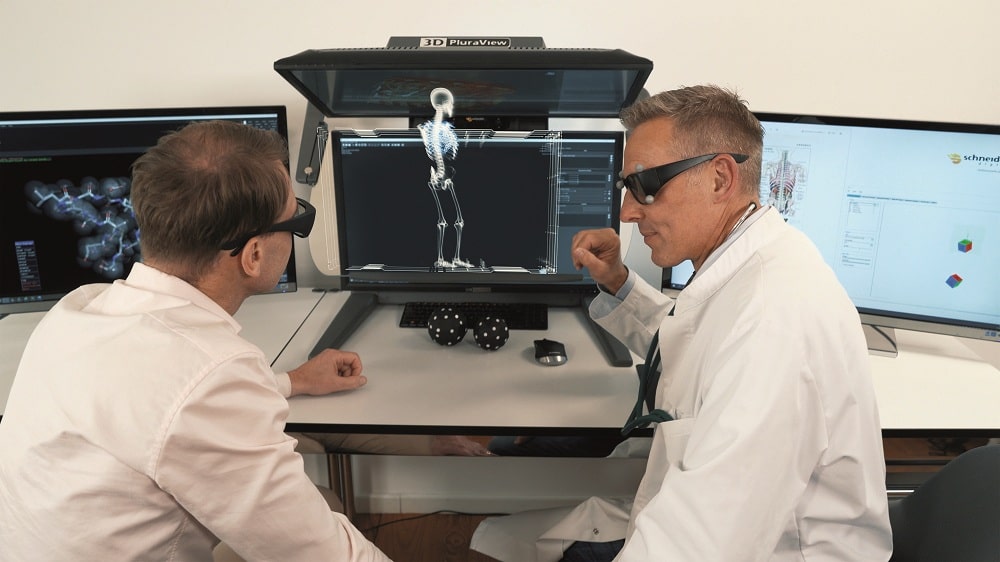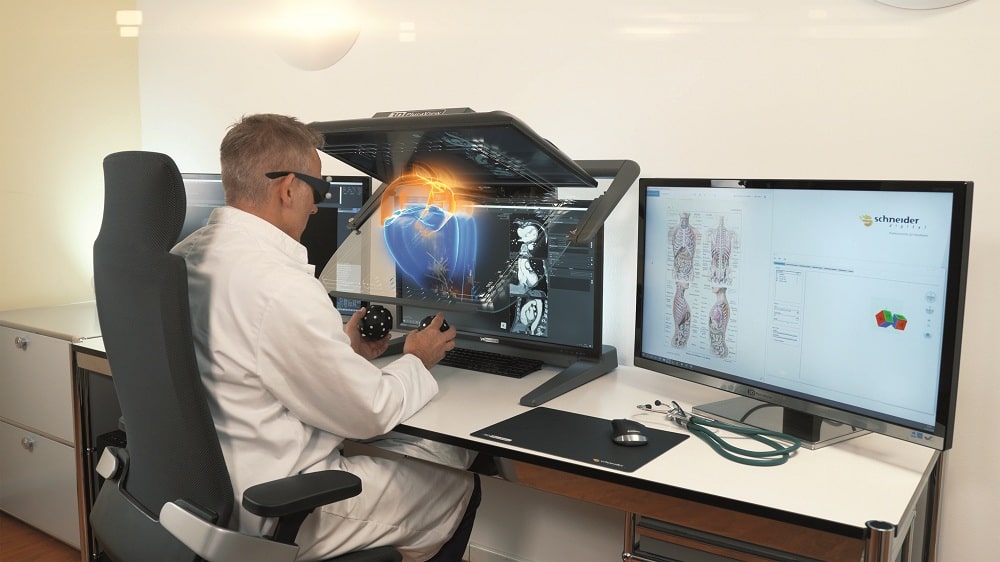



Understanding a patient’s specific anatomy is of key importance for best medical results. Fast and efficient interpretation of medical imaging is essential.
The high-resolution 3D PluraView stereo monitors from Schneider Digital are made to fit for the 3D-stereo display of medical data, especially from CT and MRI scanners and ultrasound imaging sources. Compared to other 2D and 3D-stereo desktop monitors, the PluraView have dual screens with passive beam-splitter technology to provide a realistic 3D-stereo experience, similar to a highly detailed holographic display. Combined with the Vesalius3D medical software and a suitable graphics card in a tower or laptop workstation, the PluraView stereo monitors provide a turnkey 3D workplace solution for the medical sector. The viewing and analysis of volumetric medical data can be done comfortably and efficiently at high resolution, flicker-free, even in daylight office conditions.
One of the best ways to experience medical 3D-data is stereoscopically. This replaces the 2-dimensional, perspective 3D-visualization on a single screen with real, stereoscopic depth perception. This for instance enables a doctor to “fly” virtually through a patient’s vessels, explore them in detail, analyze anatomical features in full spatial depth.
Learn More: What is Stereophotogrammetry?
The Benchmark In Medical Technology
Especially the large 27” and 28” PluraView monitors in 2.5K and 4K (UHD) resolution are the industry standard for desktop stereo displays with their wide viewing area and high brightness and contrast. The 3D-stereo visualization requirements are met for a wide variety of medical applications, such as training, surgical planning, anatomical 3D imaging and modelling, and also, pre-printing check of 3D anatomical objects is enabled.
Innovative 3D Software In Medical Technology
The workload on medical experts is ever increasing, however there is not more time. Vesalius3D helps doctors to do their work in a minimum amount of time without jeopardizing the quality. Vesalius3D is a software application for high-quality 3D-visualization and navigation through patient-specific anatomical structures. Developed in cooperation with medical specialists in the EU, the softwareis built on 20+ years of experience in medical visualization. This easy-to-use, yet powerful application is capable of displaying immersive, stereoscopic 3D datasets from standard medical formats including DICOM, created with imaging equipment, such as CT, MRI and Ultrasound.

3D PluraView and Vesalius3D for Medical Applications
Combined with the Vesalius3D and a laptop or tower-format workstation, this setup represents a truly affordable turnkey 3D workplace solution for doctor’s offices, clinics and hospitals. Together with Vesalius3D, the 3D PluraView is a key enabling factor for more detailed and highly confident decisions during team meetings, surgery planning for complex, invasive procedures. Diagnoses can be made faster, more precisely and also visualized and explained to a patient more clearly.
A modular expansion is the innovative combination with Virtual Reality technology. An integrated infrared tracking system in the 28-inch VR PluraView combines the stereoscopic display with intuitive 3D navigation and editing of 3D models. To achieve this as naturally and ergonomically as possible, tracking spheres for object movement and rotation, tracked gloves, tracked headsets and even tracked VR-scalpels can be used with Vesalius3D and the VR PluraView. In this way, stereoscopic image information can be visualized, focused-on and modified much more efficiently than would be possible with a standard mouse and keyboard interface. Very beneficial to this ‘hands-on’ interaction is the transparent beam-splitter mirror that enables users to place their hands in the same location where the image can be seen. The operators can virtually ‘hold’ the medical 3D dataset in their hands, spatially analyze, modify 3D content, discuss or present it to a group of people.
Supported data formats and data sources by Vesalius3D:
For more information please visit www.pluraview.com.